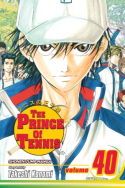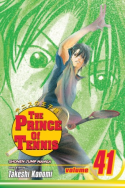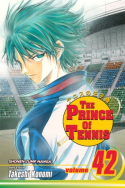 Although the final three volumes of The Prince of Tennis contain many ridiculous things and are, objectively speaking, really not that good, I still think the story wraps up reasonably well.
Although the final three volumes of The Prince of Tennis contain many ridiculous things and are, objectively speaking, really not that good, I still think the story wraps up reasonably well.
Volume 40 begins with the tail end of the set between Seishun’s captain, Tezuka, and Sanada of the Rikkai team. Tezuka is dragging things out to buy time for absentee Ryoma to arrive, and ultimately ends up losing. Then Momoshiro and Kaidou lose, but not before we get this sentence that has never been written before at any time in the course of human history: “The tornado snake won’t work against a player with red eyes.” Good to know, that.
Fuji is up next, taking on a player with the ability to mimic anyone’s ability. And who should he emulate but Tezuka, so we get a match that is drawn like the two of these guys playing against each other. Somehow I think this was intended to appeal to the fujoshi, but I’m certainly not complaining. “Maybe we’ve both been avoiding facing off against each other. Because we’re afraid of finding out who’s better,” Fuji thinks at one point. Too bad the promise of a real face-off between them is not realized before the end of the series.
 Fuji wins, so we move briskly on to the second doubles round, and somewhere around here Ryoma arrives with, and I am quoting the back cover here, “a wicked case of amnesia.” It’s completely stupid, and while Oishi and Eiji stall for time, various players (including rivals) go reacquaint Ryoma with his tennis memories by playing him off-camera. Why even employ an amnesia plot if it’s going to be cured so simply? It just makes me shake my head.
Fuji wins, so we move briskly on to the second doubles round, and somewhere around here Ryoma arrives with, and I am quoting the back cover here, “a wicked case of amnesia.” It’s completely stupid, and while Oishi and Eiji stall for time, various players (including rivals) go reacquaint Ryoma with his tennis memories by playing him off-camera. Why even employ an amnesia plot if it’s going to be cured so simply? It just makes me shake my head.
Anyway, it should be no surprise to anyone at all that Ryoma regains his memory and, though he starts off his match at a disadvantage, he soon summons the ultimate skill—“the pinnacle of perfection”—with which to vanquish his opponent. (Everyone can tell that he has achieved this because white light bursts from his body. As it often does in tennis.) And Ryoma’s dad drops by to tell everyone this is happening because Ryoma is playing simply for the joy of the game, and so that everyone can finally learn that Ryoma is the son of the famous Samurai Nanjirou. So, Seishun wins and there’s a montage while the lyrics of a song penned by Takeshi Konomi scroll by. It’s all very silly. There’s also a brief prose epilogue depicting the third years’ graduation.
 I just really don’t know what to say about The Prince of Tennis at this point. In the pursuit of ways to make games even more exciting, Konomi crossed my personal “suspension of disbelief” border with all these physically observable glowy states. Somehow, I was willing to accept Inui making instant probability calculations or Tezuka being able to control his spin so well that all return shots come directly to his location, but make a guy sparkly and have someone in the stands cry, “L-look at that! All his aura’s concentrated around his left arm!!” and it’s suddenly too much for me to take. Still, it’s not like the series was ever so fabulous that I’m actively disappointed. Just resigned.
I just really don’t know what to say about The Prince of Tennis at this point. In the pursuit of ways to make games even more exciting, Konomi crossed my personal “suspension of disbelief” border with all these physically observable glowy states. Somehow, I was willing to accept Inui making instant probability calculations or Tezuka being able to control his spin so well that all return shots come directly to his location, but make a guy sparkly and have someone in the stands cry, “L-look at that! All his aura’s concentrated around his left arm!!” and it’s suddenly too much for me to take. Still, it’s not like the series was ever so fabulous that I’m actively disappointed. Just resigned.
Anyway, thus concludes The Prince of Tennis. The sequel, Shin Prince of Tennis (“Shin” means “new”), is currently serialized in Jump SQ magazine. The fifth collected volume came out in March of this year. It lamentably remains unlicensed for US release.






























Recent Comments